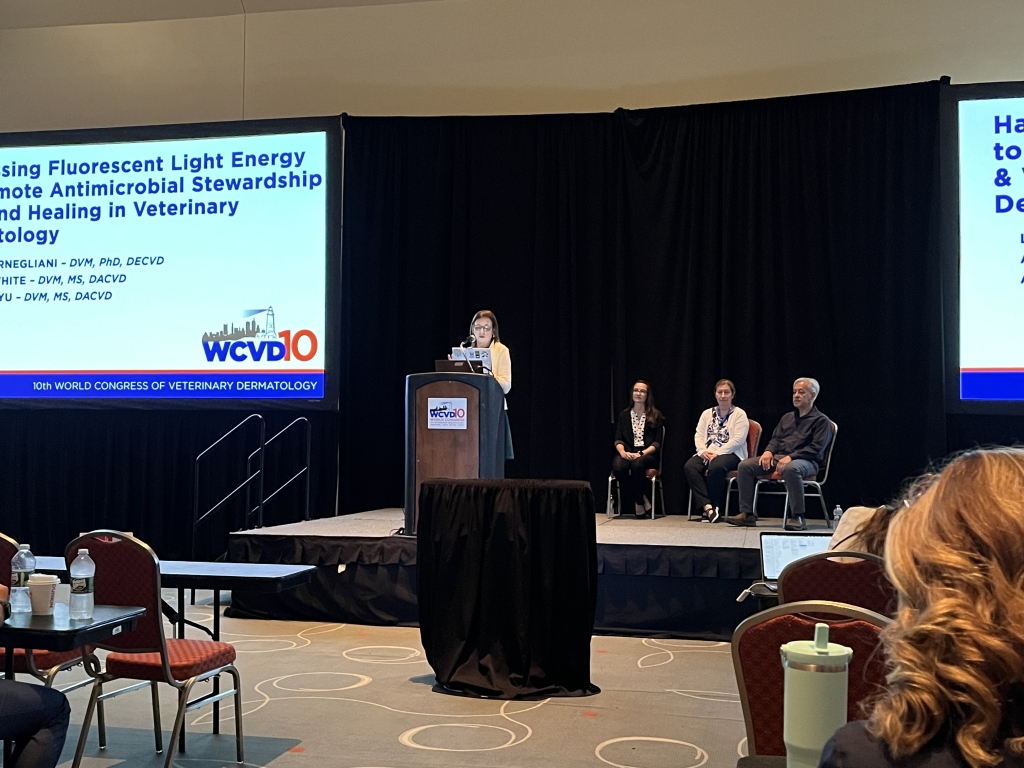
World Congress Veterinary Dermatology Symposium In Boston Highlights Innovations In Managing Skin Infections And Promoting Wound Healing
The 10th World Congress of Veterinary Dermatology in Boston brought several hundred leading veterinary dermatologists together during a symposium titled “Harnessing Fluorescent Light Energy (FLE) to Promote Antimicrobial Stewardship and Wound Healing in Veterinary Dermatology.” The event saw expert speakers Dr Luisa Cornegliani, DVM, DECVD PhD, Dr Amelia White, DVM, MS, DACVD, and Dr Anthony Yu, DVM, MS, DACVD share their latest research and clinical insights on the application of FLE in veterinary practice. The symposium, proudly sponsored by Vetoquinol, was well received by forward-thinking delegates committed to reducing antimicrobial use.
The symposium consisted of six individual lectures explaining the use of FLE in practice, spanning topics from the mechanisms of photobiomodulation to FLE evidence-based application. Dr. Anthony Yu, diplomate of the American College of Veterinary Dermatology, comments, “The implementation of FLE in veterinary practice is extremely exciting. The growing problem of antibiotic resistance and its significant impact on veterinary dermatology has underscored the urgent need for alternative therapeutic approaches. FLE provides an alternative therapeutic modality to enhance antibiotic stewardship and promote wound healing.”
A key highlight of the symposium was the session, “Mechanisms of Photobiomodulation: A Multifaceted Therapeutic Approach”, which delved into the scientific mechanisms behind FLE, explaining how it works at a photochemical and photophysical level to reduce inflammation and promote wound healing up to twice as fast.
A particularly interesting session focused on “Fluorescent Light Energy Evidence-Based Application: Literature and Caseload Analysis of Species-Specific Photobiomodulation Outcomes”. The efficacy of FLE across different species was reviewed, including studies in dogs, cats, and horses. Dr. Amelia White and Dr. Luisa Cornegliani discussed how FLE increases bacterial susceptibility, supported by case studies in canine pyoderma.
“A review of the literature shows us that FLE is beneficial in numerous dermatologic conditions and wound healing across many species.,” explains Dr. Amelia White. “A reduction of up to 50% of antimicrobial consumption can be achieved when managed with FLE compared to cases managed solely with systemic antibiotics. Furthermore, FLE reduces the owners’ stress in administering treatments at home and supports the One Health approach.”
A strong focus on providing valuable strategies for enhancing the cost-effectiveness of photobiomodulation therapy for both clients and clinics was covered in the session, “Therapeutic Optimization: Balancing Efficacy and Expenditure.” Dr. Anthony Yu expands, “FLE can be used as a monotherapy, especially in acute cases, or as an adjunctive therapy to help reduce the need for symptomatic therapy in chronic conditions.”
The symposium concluded with the presentation of the “Consensus and Clinical Guidelines: The FLE Delphi Statements.” These guidelines, developed using the Delphi method, provide best practices for implementing and optimizing FLE therapy based on expert consensus, clinical experience, and real-world evidence amongst 150 veterinarians.
The symposium highlighted significant findings, notably the potential of FLE as a tool to reduce antimicrobial use by up to 50% and accelerate wound healing up to twice as fast. More information on FLE and its uses in veterinary medicine can be found at https://www.vetoquinol.com/en/phovia/phovia_system
More from Vetoquinol
- New paper shows fluorescent light energy enhances post mastectomy wound healing in dogs
- Vetoquinol joins forces with Mission Rabies for tuk tuk challenge
- Phovia fluorescent light therapy gives pets and their owners a brighter future
- Vetoquinol launches Felpreva®, a New Three-Monthly Feline Spot-on Parasiticide
- Dr Duncan Lascelles to deliver webinar on switching NSAIDs

 2 months ago
2 months ago  371 views
371 views
